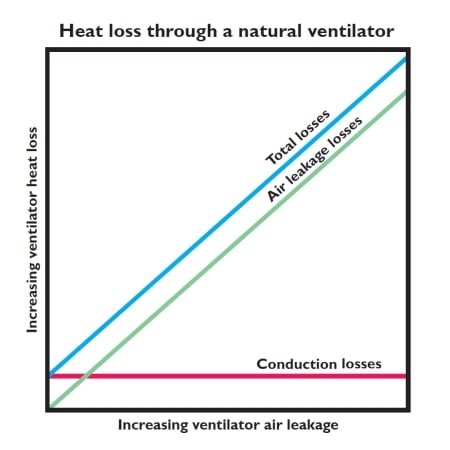You are specifying an energy efficient ventilator: what do you focus on – ventilator U value or air leakage? The simple answer is that both are important and need to be considered together.
Maximum U values and air leakage
Building Regulations for England and Wales set maximum U values for elements of building construction, including natural ventilators. For air leakage they only set a maximum level for the complete building. Since ventilators are a very small part of the overall building envelope, typically only one or two percent of the roof area, it is easy to ignore air leakage and concentrate solely on the U value. This is a mistake.
Ignore air leakage at your peril!
Let’s consider a typical sized ventilator, 1.5m x 2.5m:
- This has a plan area of 3.75m2 and a typical surface area of about 4.5m2. At the maximum permitted U value of 3.5W/m2.K, the heat loss is 15.75W/K.
- If the ventilator has an air leakage rate at the maximum permitted building air leakage of 10m3/h/m2 at 50Pa, then the leakage rate will be 45m3/h. Taking a typical air density of 1.2kg/m3, air has a thermal capacity of 1.21kW/m3.K, so the heat loss will be 15.15W/K at 50Pa pressure difference.
This means that under standard rating conditions a ventilator just meeting the minimum Building Regulations requirements will lose similar amounts of energy by thermal transmission and by air leakage, as shown in the drawing by the intersection of the red and green lines.

Watch the elemental air leakage of your ventilator
However (there’s always a however, isn’t there?) since there is no specific elemental air leakage limit there is no bar to ventilators having air leakage characteristics much worse than the building air leakage limit. In fact, if you consider the basic louvred ventilator that has been the staple of the industry for many years, the elemental air leakage can be 20 times the building limit!
Specifying energy efficient ventilators
So, the lesson is simple: if you really want your ventilator to be energy efficient, just meeting the minimum Building Regulations requirements will not do it. You need to go beyond and consider both U values and air leakage of each element.
 Paul is a Technical Director for Colt, experienced in smoke control, HVAC, solar shading and louvre systems.
Paul is a Technical Director for Colt, experienced in smoke control, HVAC, solar shading and louvre systems.

